A Floating Point Unit (FPU) accelerates software designed to use floating point mathematics — typically CAD programs, spreadsheets, 3D games and design applications. However, today’s most popular PC applications make use of both floating point and integer instructions. As a result, Cyrix chose to emphasize "parallelism" in the design of the 6x86™ processor to speed up software that intermixes these two instruction types.
The x86 floating point exception model allows integer instructions to issue and complete while a floating point instruction is executing. In contrast, a second floating point instruction cannot begin execution while a previous floating point instruction is executing. To remove the performance limitation created by the floating point exception model, the 6x86 can speculatively issue up to four floating point instructions to the on-chip FPU while continuing to issue and execute integer instructions. As an example, in a code sequence of two floating point instructions (FLTs) followed by six integer instructions (INTs) followed by two FLTs, the 6x86 processor can issue all ten instructions to the appropriate execution units prior to completion of the first FLT. If none of the instructions fault (the typical case), execution continues with both the integer and floating point units completing instructions in parallel. If one of the FLTs faults (the atypical case), the speculative execution capability of the 6x86 allows the processor state to be restored in such a way that it is compatible with the x86 floating point exception model.
Examination of benchmark tests reveal that synthetic floating point benchmarks use a pure floating point-only code stream not found in real-world applications. This type of benchmark does not take advantage of the speculative execution capability of the 6x86 processor. Cyrix believes that non-synthetic benchmarks based on real-world applications better reflect the actual performance users will achieve. Real-world applications contain intermixed integer and floating point instructions and therefore benefit from the 6x86 speculative execution capability.
The following performance summary highlights the 6x86 processor’s performance results using application categories that are particularly sensitive to floating point performance.
The Winstone® 96 benchmark suite is representative of the majority of applications used by PC buyers. It incorporates popular software in the business graphics/desktop publishing, database, spreadsheet and word processing categories. Of the Winstone 96 application categories, floating point calculations are most commonly used in the spreadsheet applications.
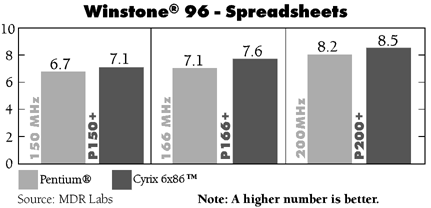
In addition to Winstone 96, Ziff-Davis also distributes the Winstone 32 benchmark. Winstone 32 is a suite of popular 32-bit applications that includes a combined Word Processing/Spreadsheet category. Results are shown below.
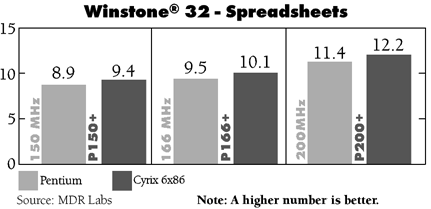
In each case shown above, the 6x86 processors perform better than the comparable Pentium® processors.
A second application area that uses floating point instructions but is not represented in the Winstone 96 or Winstone 32 suites is computer-aided design (CAD). To measure the 6x86 processor’s performance for this application category, two independent benchmarks were used: the San Diego AutoCAD User’s Group Benchmark, and Cadalyst Magazine’s Systems Benchmark 96. The Cadalyst Systems Benchmark includes both a 2D and a 3D index. In each case, the 6x86 performs better than the comparable Pentium processor, as shown below.
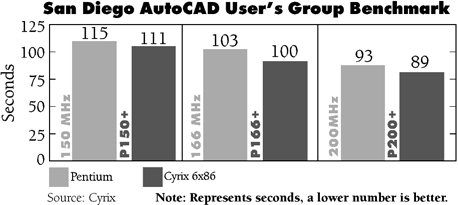
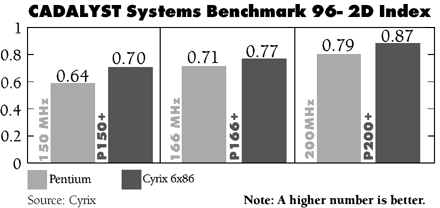
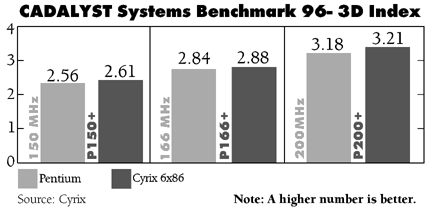
The final popular application category that uses floating point instructions is 3D games. The benchmarks available for 3D games are distributed by various games vendors and measure display frame rate. These benchmarks are very sensitive to bus frequency and the graphics subsystem in addition to the processor performance. To achieve smooth motion, the frame rate typically needs to be greater than approximately 13 frames/second. As a reference, full motion video is achieved with a frame rate of approximately 30 frames/second.
The following game benchmarks were run with a 2D graphics card.
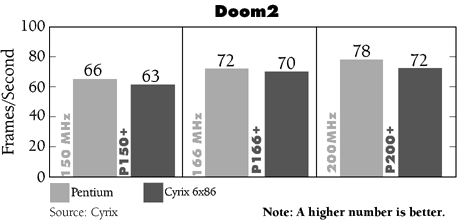

The following benchmark illustrates 3D game performance using a 3D accelerator card.
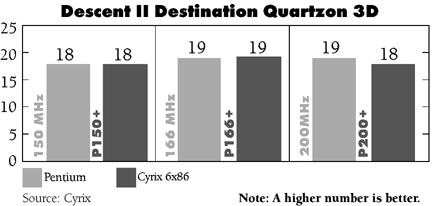
The 6x86 processor performs equal to the comparable Pentium in some cases, while the Pentium performs better in others. However, in all cases, both the 6x86 and Pentium processors achieve the smooth motion frame rate of greater than 13 frames/second.
Configurations for the Cyrix 6x86-PR166+ and 6x86-PR150+ processors, and the 166 MHz and 150 MHz Pentium processors use identically configured systems: Tyan S1562 motherboard (TritonHX chipset); 512K pipelined-burst L2 cache, 32MB EDO DRAM; Adaptec 2940u SCSI controller; Matrox Millennium with 4MB WRAM; Seagate ST32550N Barracuda drive. The Cyrix 6x86-PR200+ and the 200 MHz Pentium processors use the same components listed above with one exception: the Cyrix 6x86-PR200+ processor uses a DFI G586VPS Pro motherboard (VLSI Lynx chipset) to support the processor’s 75 MHz bus.
| 6x86 Processor Performance Benchmarks | Cyrix 6x86 Processor Brief |
| Home | | New Parts Price List | | Used Parts Price List | | Specials | | Service | | Contact | | Tech Info | | About |